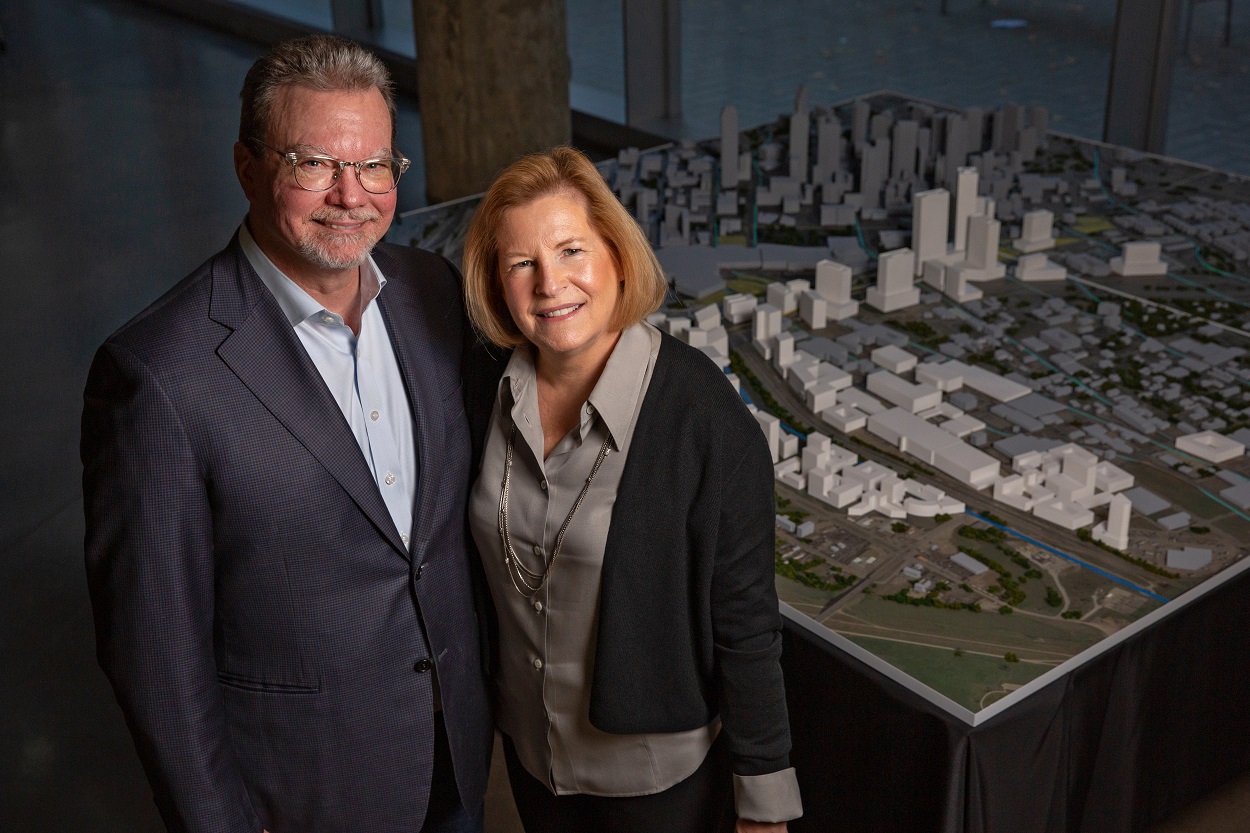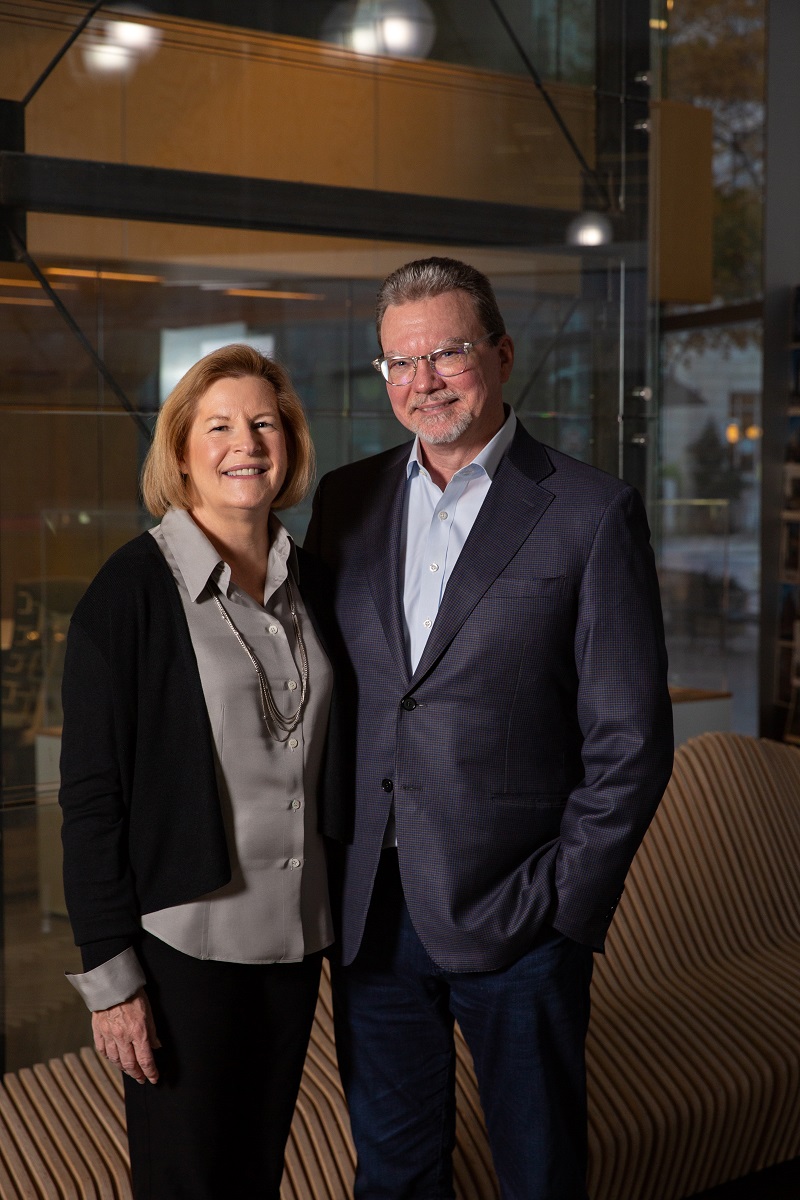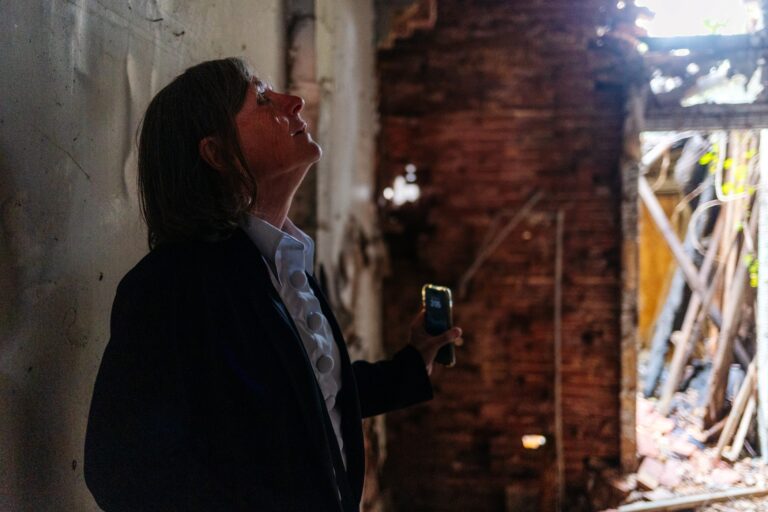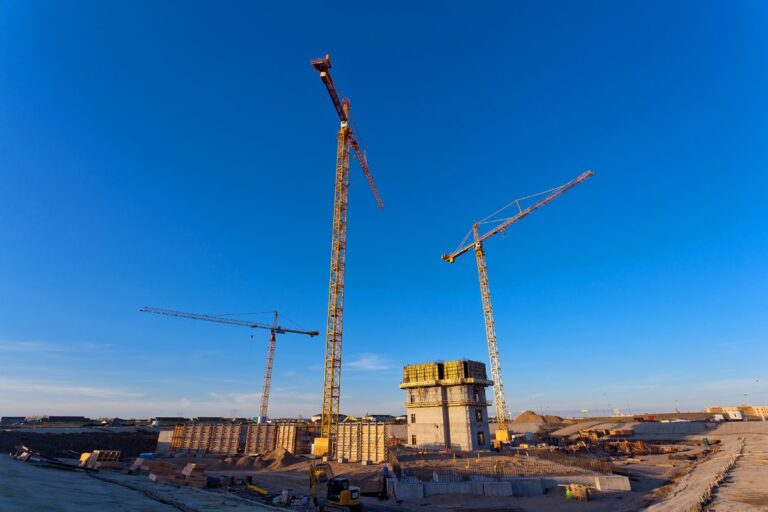Architect Kathleen Lechleiter ’81, ’82 is shaping safe, stable, and dignified housing in Baltimore neighborhoods.
Read MoreDesigning the Skyline
Winston Churchill said, "We shape our buildings, and afterwards our buildings shape us." For architects Ann and Dan Noble, shaping a skyline is a humbling responsibility, so they're doing more to better serve people in the spaces they design.
Story by Nicole Thom-Arens | Photos by Shelby Tauber | April 11, 2022

About 10 years ago, Dan Noble ’82 found himself riding in a handmade 750 BMW in Dubai. He traveled there from Dallas, Texas, on business for HKS Architecture, where he is now chairman, president, and CEO. He turned to the driver — dressed in a white Kandura — who was leaned way back in his seat and smoking a cigarette. Behind him, through the driver’s window, Dan could see the Dubai skyline. It was in that moment that he wondered, “How did I get here?”
When I flew into Dallas from Fargo, North Dakota, to interview Dan and Ann (Skjerven) Noble ’82, I got caught in rush hour traffic on the freeway while making my way from the airport to downtown Dallas. As I drove into the city filled with brightly lit high-rises, I wondered if the stark contrast of life in Fargo and life in one of the largest metro areas in the U.S. ever made either of them take pause, so I asked.
“Where it really strikes me is when we travel,” Dan, who grew up in Aberdeen, South Dakota, said. “We have offices in Dubai, Shanghai, India, London, Mexico City, Singapore. When you look at it through that context, Dallas seems like an easy jump. How did we end up here? OK, I can get that. How did we end up in India?”
Dan and Ann, who grew up in Park River, North Dakota, met at NDSU — in fact, they were in the same freshman English class — but it wasn’t until later in their academic careers that they started dating. After graduating with degrees in architecture, they went their separate ways. Ann headed to Chicago, Illinois, where her brother was living but she couldn’t find a job in the city.
“They were laying off in droves that summer,” Ann recalled. “We had a friend, one of our classmates, from Dallas, who was going up north to pick up his car at Thanksgiving who said, ‘Just drive down with me.’ I slept on his couch and had three job offers in the first week. I came down to Dallas for what was just going to be a couple of years, and that was 40 years ago.”
Dan spent the first summer after graduation earning money painting houses and organizing his portfolio. In the fall, he drove from Aberdeen to Houston, Texas, where his brother and sister were living. He found a job, but when the oil crisis hit Houston, the firm closed. After six months of waiting tables, he left Houston and headed to Dallas. He’d wanted to be an architect for as long as he could remember, so he thought he better “pursue his vocation.”
"We put a lot of our effort into the things we feel there's a need for in the world. We're finding there's a business proposition for that. We can do good and create a viable business by doing good."
Dan Noble
When he arrived in Dallas, he researched architecture firms in the city, noted the ones that had won the most design awards, and applied to those.
“HKS was one of those firms. I interviewed here and got the job in ’83, so it’s been 39 years,” Dan said. “I was a project designer, then a senior designer, moved into healthcare, became studio director, became director of design for health, and then director of design for the whole firm, then CEO eight years ago.”
Ann started at a small firm in Dallas, Craycroft Architects, and then went to a commercial firm before landing at HKS in September 1986. People in the office were a bit confused when Ann and Dan married in January 1987.
“People thought we met and got married, but we had known each other for nine years at that time,” Ann laughed.
In the mid-1980s, HKS was a 150-person firm with a great technical reputation. Ann credits Dan with his efforts to improve design at the firm during his tenure.
“As Dan came up the ranks and was promoted to director of design, he said, ‘We’re going to push this,’ and has really been pushing it ever since,” Ann recalled. “They had the project management and technical aspects taken care of and were known for it, so in enhancing the design, everything enhanced.”
They both agree the firm’s strong business practices are also part of its longevity. While other architecture firms in the city have closed their doors in the time Ann and Dan have been in Dallas, HKS has grown to 1,500 employees, expanded into 24 cities around the world, and been in business for more than 80 years.

“This is a profession where you can over emphasize aspirational design, ego-drive, selfish aspects of what the profession could be. All of that taken in moderation is necessary, but when it gets out of balance, it becomes a problem. It’s hard to run a business that way,” Dan said about some firms where the culture is more singularly ego-driven and less about collaboration and understanding user needs.
“And you’ve got a good succession plan in place,” Ann added. “In some firms, the leader gets old and doesn’t have anyone lined up to take over, so when he retires, the firm is gone.”
It’s also clear HKS is a firm that invests in its people. In 1996, Ann was pregnant with their second child and working for another company — she felt she needed a break from HKS. Former CEO Joe Buskuhl called Ann and asked her to come back to HKS. He realized the firm was losing talent when women were starting families and he wanted to work out ways to retain them.
“I think I was, if not the first, one of the first women to try going part time,” Ann remembered. “I was involved in overall project management, which was hard to do part time, so I gravitated toward the technical side. I got involved with our quality control group and our technical specifications, which was easier to do part time. I started at 30 hours a week then went down to 20.”

As CEO, Dan continues the firm’s tradition of re-envisioning the workplace to meet the needs of its employees, but he is also working on ways to make the world a better place to live in. They don’t just hire architects and interior designers. The team also includes sociologists, researcher scientists, industrial engineers, psychologists, ecologists, and anthropologists.
“HKS embodies the idea that architecture and design is a much broader field than one department and one discipline,” Michael Strand, director of NDSU’s School of Design, Architecture, and Art, said. “The holistic view of design holds multiple vantage points and is something that really shows up in what the firm does.”
HKS is the only architecture firm in the world to sign the UN Global Compact, which aims to “mobilize a global movement of sustainable companies and stakeholders to create the world we want.” They’re leading internal conversations about justice, equity, diversity, and inclusion. They’ve created an advisory group, a sustainability group, and launched Citizen HKS, the firm’s pro bono arm, of which Ann is a member of the steering committee.
“We put a lot of our effort into the things we feel there’s a need for in the world,” Dan said. “We’re finding there’s a business proposition for that. We can do good and create a viable business by doing good.”
Dan is also leaning into the new business culture of a distributed workforce. The seven-floor office space is no longer filled with people in workspaces like it was prior to the pandemic. They’re engaging in a flexible work experience and utilizing software to keep the hundreds of teams collaborative.
“We don’t have a defined eight to five you have to be in the office anymore, and we won’t. It’s about how to balance your work with your life,” Dan said.
While they encourage balance, both Ann and Dan exemplify the characteristic Midwestern work ethic. They know that sometimes work aligns with passion and balance doesn’t come every day.

In addition to building their careers and raising their family, they’ve also renovated three of their family homes, built their current home, and are now working on a lake house in Brainerd, Minnesota.
“We’ve always had side projects that keep us up at night,” Dan said.
“Space effects people. It does,” Ann said. “Even the spaces that we’ve done, I think about our kids growing up in the homes that we’ve renovated, and, hopefully, it enriched them. I think it has.”
Ann retired from HKS when Dan became president and CEO. She leaned into her interests in building and construction — the things that first inspired her to study architecture. She and a friend started a business flipping houses.
“We’ve renovated and flipped three houses now. Three teeny, tiny houses. So, when Dan was going off to his big job, and he’d say, ‘What are you going to do today?’ I’d say, ‘I’m going to save the world — one tired little house at a time.'”
Dan’s first design project also involved construction. When he was in sixth grade, he converted the family home’s cistern into a bedroom for his brother. At NDSU, both Ann and Dan realized architecture was about more than seeing a need and fulfilling it.
“I’d never thought about the psychology of architecture, the sociology. How space effects mood. How space can improve productivity. How healthy buildings can create a happier workforce. How if you just don’t do these one-off buildings where they’re not connected, that you could create a cohesive urban environment and if you did, how much better it would be,” Dan said while crediting NDSU faculty members Roger Richmond and Al Cook for encouraging new ways of thinking about space and design.
“Michael Ward was a big influencer in conceptual design — looking at architecture as more than just buildings to shelter. It’s spaces that influence and effect people,” Ann added.
As they recall stories about their time at NDSU, the fondness they have for this place is obvious. Ann has been an NDSU Foundation Trustee since 2019, and when she and Dan make trips back to campus, they’re even more impressed with how the School has evolved since they’ve graduated, and they’re passionate about helping students graduate and find their own enriching careers in the field.
So how did the Nobles get where they are today? Dan answers his own question.
“There wasn’t a big plan. Things just sort of fell into place. We did what we loved to do, we worked hard, and were passionate about it,” he said. “We had a real sense of purpose and knew where we wanted to make a difference.”
Share This Story
Related Stories
Structures of Connection
Joanna Slominski ’04 wants us to think differently about construction — it’s more than bricks and concrete.
Read More
